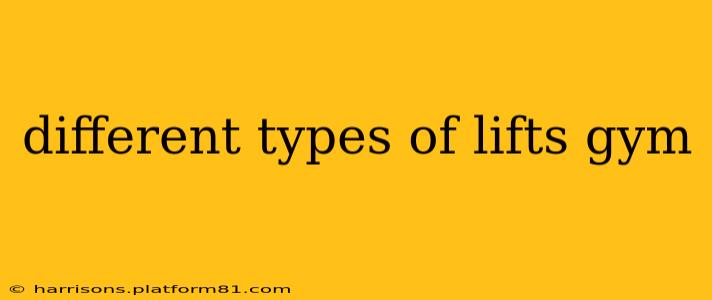The gym can feel like a confusing maze of machines and free weights, especially when you're just starting out. Understanding the different types of lifts is crucial for building strength, muscle mass, and overall fitness. This guide breaks down various gym lifts, categorizing them for clarity and explaining their benefits. We’ll cover everything from fundamental compound movements to more isolation-focused exercises.
Compound Lifts: The Foundation of Strength Training
Compound lifts are exercises that work multiple muscle groups simultaneously. They are incredibly efficient for building overall strength and muscle mass. These are the cornerstones of any effective strength training program.
1. Squats: The King of Leg Exercises
Squats are arguably the most important compound lift. They primarily target the quadriceps, hamstrings, and glutes, but also engage the core for stabilization. Variations include:
- Barbell Back Squats: The classic squat, using a barbell across the upper back.
- Front Squats: The barbell rests across the front of the shoulders. This emphasizes the quads more.
- Goblet Squats: Holding a dumbbell or kettlebell close to the chest. A great beginner variation.
- Overhead Squats: Holding a barbell overhead. Requires significant mobility and balance.
2. Deadlifts: The Full-Body Powerhouse
Deadlifts engage nearly every muscle group in the body, making them incredibly effective for overall strength and power development. Proper form is paramount to avoid injury. Key variations include:
- Conventional Deadlifts: The most common variation, with the barbell positioned in front of the feet.
- Sumo Deadlifts: A wider stance with the feet positioned outside the shoulders.
- Romanian Deadlifts (RDLs): Focuses more on the hamstrings and glutes.
3. Bench Press: Chest Domination
The bench press is a classic upper-body exercise targeting the chest, shoulders, and triceps. Variations include:
- Barbell Bench Press: The standard barbell press, performed lying on a bench.
- Incline Bench Press: Performed on an inclined bench, emphasizing the upper chest.
- Decline Bench Press: Performed on a declined bench, targeting the lower chest.
- Dumbbell Bench Press: Using dumbbells allows for a greater range of motion and independent arm movement.
4. Overhead Press: Shoulder Strength and Stability
The overhead press, also known as the shoulder press, targets the shoulders, triceps, and upper back. Variations include:
- Barbell Overhead Press: Using a barbell overhead.
- Dumbbell Overhead Press: Using dumbbells allows for a greater range of motion.
- Arnold Press: A variation incorporating an external rotation of the arms.
Isolation Exercises: Fine-Tuning Your Physique
Isolation exercises focus on a single muscle group, allowing for targeted muscle growth and refinement. These are often used after compound lifts to further develop specific areas.
1. Bicep Curls: Arm Power
Bicep curls target the biceps brachii. Variations include:
- Barbell Curls: Using a barbell.
- Dumbbell Curls: Using dumbbells.
- Hammer Curls: Palms facing each other.
- Concentration Curls: Focusing on one arm at a time.
2. Triceps Extensions: Shaping the Back of the Arm
Triceps extensions isolate the triceps brachii. Variations include:
- Overhead Dumbbell Extensions: Extending the arms overhead.
- Skullcrushers: Lying on a bench and extending the arms.
- Cable Pushdowns: Using a cable machine.
3. Leg Extensions: Quadriceps Focus
Leg extensions specifically target the quadriceps muscles.
4. Hamstring Curls: Targeting the Back of the Legs
Hamstring curls isolate the hamstring muscles.
What are some other common gym lifts?
This question encompasses a wide range of exercises beyond the compound and isolation categories already discussed. Many other exercises fall under specific categories like:
- Calf Raises: Focusing on the calf muscles.
- Pull-ups/Chin-ups: Working the back and biceps (requires significant upper body strength).
- Rows (Barbell Rows, Dumbbell Rows, Cable Rows): Targeting the back muscles.
- Lateral Raises: Targeting the shoulders.
- Lunges: Working the legs and glutes (can be considered a compound movement).
What are the best lifts for beginners?
For beginners, focusing on mastering proper form with fundamental compound movements is key. Start with:
- Goblet Squats: Easier on the back than barbell squats.
- Dumbbell Bench Press: Allows for better control and range of motion.
- Dumbbell Rows: Easier to maintain good form compared to barbell rows.
- Overhead Dumbbell Press: A safer alternative to the barbell overhead press for beginners.
Remember to consult with a qualified fitness professional before starting any new workout routine. Proper form and progressive overload are essential for safe and effective strength training. Enjoy the journey of building strength and fitness!
